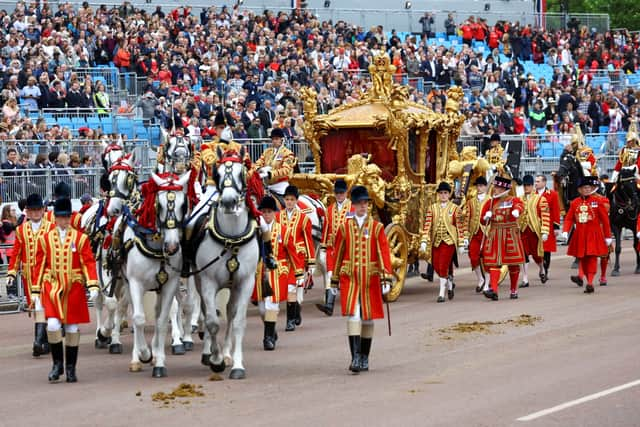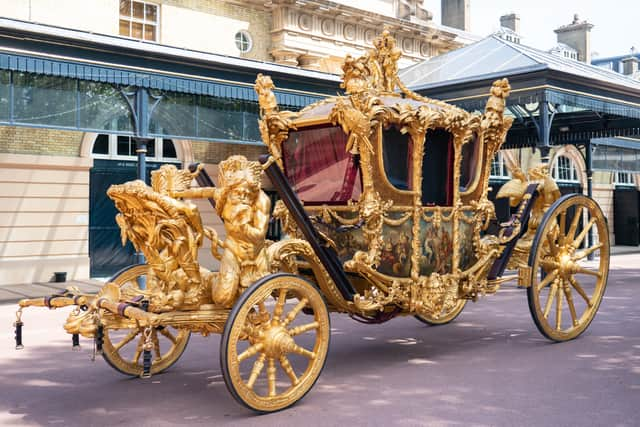Is the Gold State Coach made of real gold? What is it’s worth, how heavy is it
and live on Freeview channel 276
The Gold State Coach will play a significant role in the coronation of King Charles and Camilla, Queen Consort this weekend.
The historic vehicle will be used for the procession following the ceremony at Westminster Abbey on Saturday (6 May). For the outbound journey from Buckingham Palace they will use the modern Diamond Jubilee State Coach.
Advertisement
Hide AdAdvertisement
Hide AdBuckingham Palace have unveiled plans for the highly anticipated ceremony. It includes revealing the route the couple will take on the day.
A full list of the crown jewels that will feature in the coronation have also been confirmed. There will also be a special Twitter emoji inspired by the St Edward’s Crown.
But what is the Gold State Coach made from? How heavy is it - and why is it disliked by monarchs? Here is all you need to know:
Gold State Coach to be used for procession
The impressive Gold State Coach creaks like an “old galleon” as it rolls along, but runs a lot smoother than it used to, the man in charge of its care has revealed. Martin Oates, senior carriage restorer at the Royal Mews, will walk behind the four-tonne carriage in the King’s coronation procession and act as the “brake man” pulling the hand-held T-bar at the back to secure it in place when it stops.
Advertisement
Hide AdAdvertisement
Hide AdOnly a sovereign and their consort are permitted to travel in the historic Gold State Coach, which is more than 260 years old. Charles and the Queen Consort will use it for the first time on their journey back to Buckingham Palace after being crowned in Westminster Abbey.


Mr Oates said of the Gold State Coach: “When you’re following it, you can hear it creaking so it sounds like an old galleon going along. It’s not quite a washing machine, but where other vehicles just go from back to front, this is moving from side to side.”
Mr Oates said the four original leather straps which support the body of the Gold State Coach, which dates from 1762, were replaced 15 years ago.
“When we actually took them off, they were different sizes,” he said. “Now they’re all the same size so that could actually help towards the fact that it actually runs a lot better.”
Is the Gold State Coach made from solid gold?
Advertisement
Hide AdAdvertisement
Hide AdDespite the name, the royal carriage is not actually made from solid gold. On the Royal Collection Trust’s website it explains: “The coach is actually made of giltwood, which is a thin layer of gold leaf over wood. The interior is lined and upholstered with velvet and satin. It also features magnificent painted panels of Roman gods and goddesses.
“It features gilded sculptures including three cherubs on the roof, which represent England, Scotland, and Ireland. And above each wheel there is a massive triton figure.”


How heavy is the Gold State Coach?
The grandest royal coach in the Royal Mews was first used by George III. It weighs four tonnes and is 3.6 metres tall and seven metres long and needs eight horses to pull it.
It will take 20 people to push it out of its permanent home in the Royal Mews into the courtyard ready for the coronation, and a window and a door will have to be removed to create enough space for the huge carriage to pass through into the open air.
Advertisement
Hide AdAdvertisement
Hide AdBecause of its age and and how heavy it is, it is only ever used at a walking pace.
What is it worth?
The Gold State Coach was first comissioned in the 1760s and cost the Royal family £7,562 at the time - which is around £3.5m today.
Due to its significance and history it is priceless and likely worth far more than its original cost.
Why is Gold Stage Coach disliked?
Elizabeth II once described her journey to and from the coronation in the bumpy Gold State Coach as “horrible”. A hot water bottle was strapped under her seat to keep her warm during the unseasonably cold day in June 1953.
Advertisement
Hide AdAdvertisement
Hide AdThe carriage has been used at every coronation since 1831, but even the then-monarch William IV – who was known as the Sailor King – likened it to “being aboard a ship tossing in a rough sea”. Queen Victoria was not a fan and complained of its “distressing oscillation”.
The coach features magnificent painted panels of Roman gods and goddesses, rich gilded sculptures including three cherubs on the roof representing England, Scotland, and Ireland, and four massive triton figures above each wheel.
The front panel includes a figure of Britannia sitting on the banks of the River Thames, with the dome of St Paul’s Cathedral just visible in the city.
It was last seen on the streets of London for the Platinum Jubilee pageant, when it travelled empty except for archive footage of Elizabeth II on her coronation day projected on to its windows. Before that, it had not been used since the Golden Jubilee of 2002.
Royal couple to first travel in Diamond Jubilee coach
Advertisement
Hide AdAdvertisement
Hide AdTheir outward trip to the abbey will be made in the more comfortable, modern Diamond Jubilee State Coach, which Mr Oates described as more like a car with its mod-cons of air conditioning and hydraulic shock absorbers.
The black Diamond Jubilee carriage with its gilded decorations is the newest coach in the Royal Mews. It was first used at the State Opening of Parliament in June 2014 and has heating, internal lights and power windows.
Mr Oates, who is the fourth generation of his family to work in the Mews, said: “(The Diamond Jubilee State Coach) has shock absorbers on it. It’s a much more modern vehicle. It’s much like a car.”
The carriage is more than five metres long, weighs over three tonnes and needs six horses to pull it. Built in Australia, it combines traditional craftsmanship and modern technology and its aluminium body is prevented from swaying by six hydraulic stabilisers.
Its interior is made from objects donated by more than 100 historic sites across Britain.
Comment Guidelines
National World encourages reader discussion on our stories. User feedback, insights and back-and-forth exchanges add a rich layer of context to reporting. Please review our Community Guidelines before commenting.